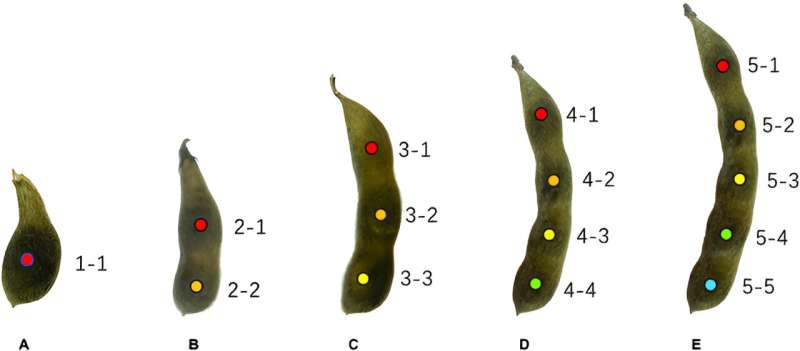This article has been reviewed according to Science X's editorial process and policies. Editors have highlighted the following attributes while ensuring the content's credibility:
fact-checked
trusted source
proofread
New model enhances high-throughput phenotyping of soybean pods and seeds

Soybean is an agriculturally important legume rich in protein and oil, with breeders aiming to enhance yields through traits like seed weight, shape, and pod count. Current research leverages deep learning (DL) for high-throughput phenotyping, yet conventional methods are laborious and error-prone.
Segmentation-based and detection-based DL methods face challenges with dense, overlapping pods. To address these issues, the focus has shifted to exploring point-based detection methods, such as P2PNet, to accurately phenotype soybean pods and seeds in situ.
A research team has developed the DEKR-SPrior model to improve high-throughput phenotyping of soybean pods and seeds. This model, which enhances feature discrimination through a novel SPrior module, significantly reduces the mean absolute error in pod phenotyping compared to existing models.
DEKR-SPrior's ability to accurately count and locate densely packed pods and seeds promises to streamline soybean breeding processes, offering a valuable tool for enhancing crop yield predictions and advancing agricultural research.
The study, published in Plant Phenomics on 27 Jun 2024, proposes the DEKR-SPrior model, incorporating structural prior knowledge, to improve the accuracy of soybean pod phenotyping.
In this study, the performance of the DEKR-SPrior model was compared with four other bottom-up models—Lightweight-OpenPose, OpenPose, HigherHRNet, and the original DEKR, on a high-resolution sub-image dataset comprising 205 cropped soybean plant images.
DEKR-SPrior demonstrated superior accuracy, with AP, AP50, AP(1-seeded), AP(2-seeded), AP(3-seeded), and AP(4-seeded) values of 72.4%, 91.4%, 71.7%, 80.9%, 85.6%, and 83.6%, respectively. Compared to the original DEKR, DEKR-SPrior showed notable improvements across all metrics, particularly with significant gains in AP for 2-seeded and 3-seeded pods.
Precision-recall (PR) curves indicated that DEKR-SPrior maintained higher precision at given recall rates, effectively reducing missed and incorrect detections. The visualization of results showed accurate identification and connection of seed positions, even in densely packed pods.
Ablation analysis further confirmed the enhancement provided by the SPrior module, with optimal performance achieved at a specific hyperparameter value.
DEKR-SPrior also outperformed other models in full-sized image tests, achieving lower mean absolute errors (MAE) and higher Pearson correlation coefficients (PCC) for both seed and pod counts, underscoring its efficacy in soybean phenotyping.
According to the study's lead researcher, Jingjing He, "This paper demonstrated the great potential of DEKR-SPrior for plant phenotyping, and we hope that DEKR-SPrior will help future plant phenotyping."
In summary, the DEKR-SPrior model achieved higher precision and recall rates, demonstrating its effectiveness in accurately detecting and counting soybean pods and seeds. Looking to the future, DEKR-SPrior holds great potential for advancing agricultural research and breeding programs by providing a more accurate and efficient method for phenotyping crop traits.
This model could be further refined and adapted for other crops, enhancing yield prediction and contributing to food security.
More information: Jingjing He et al, DEKR-SPrior: An Efficient Bottom-Up Keypoint Detection Model for Accurate Pod Phenotyping in Soybean, Plant Phenomics (2024). DOI: 10.34133/plantphenomics.0198
Provided by Chinese Academy of Sciences





















